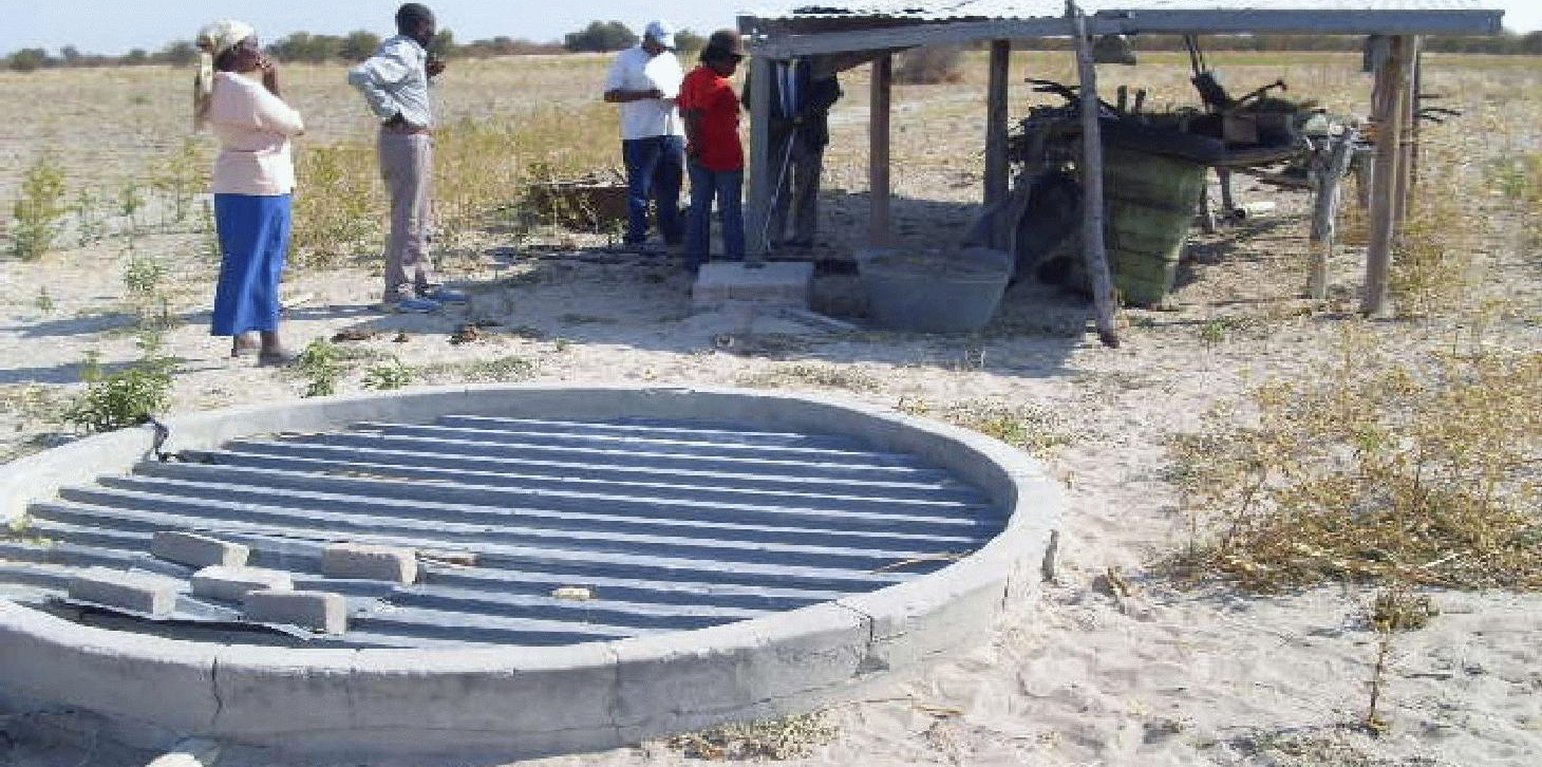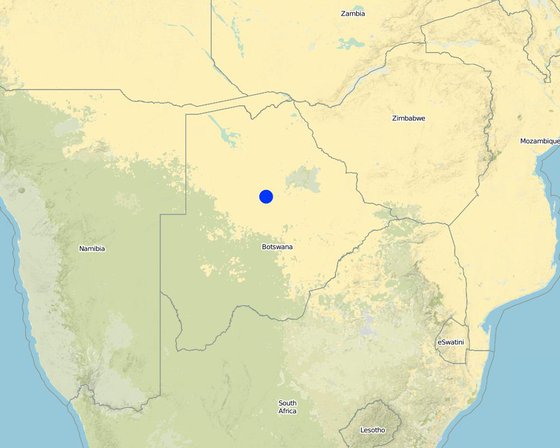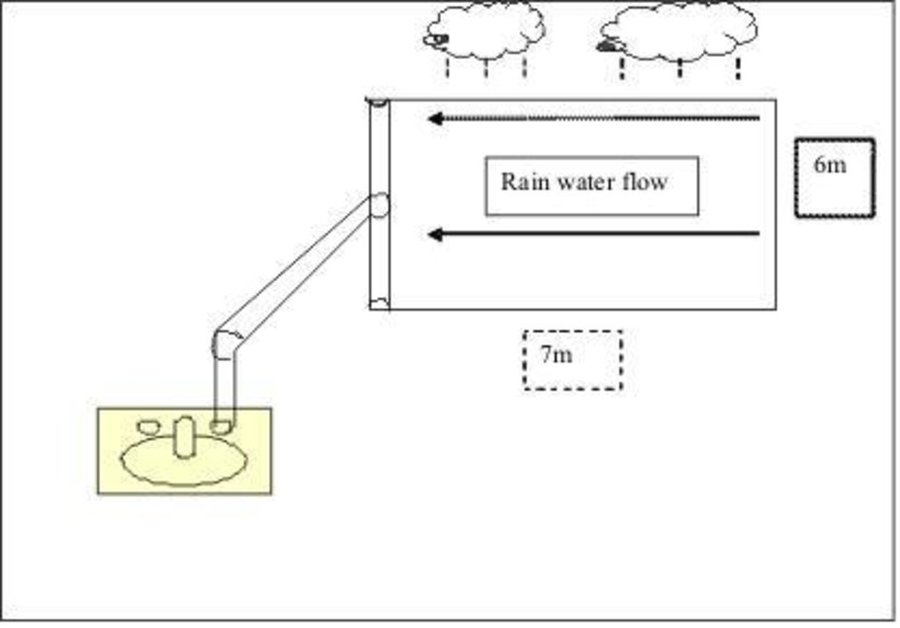



A roof of galvanised iron (corrugated iron) with the dimensions 7 x 6m is constructed on a support of gum poles (see photos). The roof catches the rain. The rain water flows over the roof into pipes at the rear end of the roof (sloping side) into an underground conical water tank. The tank is made of bricks and mortar. The underground tank serves two key roles: i) it stores water for use during the dry spells or times of no rain; and ii) the tank keeps the water cool in this hot environment. The technology is most preferred for so-called ‘lands’ areas, to provide household drinking water. On average, these lands are distant from water sources (e.g. 2-15 km). Other benefits of storing rainwater include less pressure on natural water ponds, but this would be a secondary concern
Water is critical for human consumption and needed around the home. The cool water is effective in quenching the thirst; it reduces labour time to collect water thus freeing time to concentrate on other farm activities. The water is mainly for household drinking and household chores like washing. Some is used as drinking water for chickens and for the animals used for draught power (e.g. donkeys during ploughing). The units are for use by individual farmers and thus restricted to individual households. The owner or the farmer has exclusive rights to the use of the water. Some farmers indicated that, in times of no rain, or before the first rains, they collect water from the village in drums, and pour it into this underground water tank, thus using it as a reservoir. They especially like the persistent coolness of water stored in the underground tank.
The technology is for rainwater collection in four villages. Rainwater that flows over the roof is collected, for example, on galvanised iron roofs. The water then runs through gutters and a pipe to the underground water tank. To build the underground tank, the ground is excavated, to about 2m deep and about 3m wide. Within this hole, a drum-like feature is built with concrete bricks and mortar. After the wall of the tank is complete, it is then lined with mortar from the inside, and the base is also lined to form the completed tank. It is then sealed at over most of the surface leaving an opening with a lid. This opening is large enough for a man to enter for occasional cleaning of the groundwater tank. Thus the system comprises a roof, for collecting rainwater, and an underground tank for storing it.
The environment is semi-arid and seasonal rainfall dominates during the summer months of October to April. People depend on nearby boreholes for water in the lands areas or have to travel to the village (about 2-5km away on average, but can be up to 15km) to fetch water. Most boreholes are either privately owned or communal and water is rationed to about two drums per week or even fortnightly. Most of the borehole water in the area is brackish. Thus roof rainwater (which is fresh) acts as the preferred alternative source of water. The underground tank, once full, is equivalent to 110 drums. Most normal rain events fill the tank, and the water remains in use till the next rainy season, which was found to be the case at all four pilot sites visited. Thus the rainwater catchments systems offer water security in the lands areas; water of very good drinking quality (sweet taste, cooler).

الموقع: Central District, Boteti area, in Central District of Botswana, بوتسوانا
عدد مواقع تنفيذ التقنيةالتي تم تحليلها:
انتشار التقنية:
في منطقة محمية بشكل دائم؟:
تاريخ التنفيذ: منذ 10-50 سنة
نوع التقديم





| تحديد المدخلات | الوحدة | الكمية | التكاليف لكل وحدة (Pula) | إجمالي التكاليف لكل مدخل (Pula) | % من التكاليف التي يتحملها مستخدمو الأراضي |
| العمالة | |||||
| labour | ha | 1,0 | 12,5 | 12,5 | 100,0 |
| labour by gov (8 person days) | ha | 1,0 | 500,0 | 500,0 | |
| مواد البناء | |||||
| sand, cement, concrete block | ha | 1,0 | 1500,0 | 1500,0 | 100,0 |
| إجمالي تكاليف إنشاء التقنية | 2'012.5 | ||||
| إجمالي تكاليف إنشاء التقنية بالدولار الأمريكي | 251.56 | ||||
| تحديد المدخلات | الوحدة | الكمية | التكاليف لكل وحدة (Pula) | إجمالي التكاليف لكل مدخل (Pula) | % من التكاليف التي يتحملها مستخدمو الأراضي |
| العمالة | |||||
| labour | ha | 1,0 | 12,5 | 12,5 | 100,0 |
| إجمالي تكاليف صيانة التقنية | 12.5 | ||||
| إجمالي تكاليف صيانة التقنية بالدولار الأمريكي | 1.56 | ||||
الكمية قبل الإدارة المستدامة للأراضي: 0.15 t/ha/y
الكمية بعد الإدارة المستدامة للأراضي: 0.195 t/ha/y
30% increase due to more time to manage crops better e.g. weeding
mainly chickens and small stock
الكمية قبل الإدارة المستدامة للأراضي: 40%
الكمية بعد الإدارة المستدامة للأراضي: 10%
more time on farm
water year round
الكمية قبل الإدارة المستدامة للأراضي: 5%
الكمية بعد الإدارة المستدامة للأراضي: 90%
at construction phase only
الكمية قبل الإدارة المستدامة للأراضي: 3%
الكمية بعد الإدارة المستدامة للأراضي: 25%
from horticulture, chickens etc
الكمية قبل الإدارة المستدامة للأراضي: 5%
الكمية بعد الإدارة المستدامة للأراضي: 90%
poor cannot afford it
no time lost in collecting water afar
الكمية قبل الإدارة المستدامة للأراضي: 5%
الكمية بعد الإدارة المستدامة للأراضي: 35%
better yields with more on-farm time
الكمية قبل الإدارة المستدامة للأراضي: 5%
الكمية بعد الإدارة المستدامة للأراضي: 40%
the water is better than in region
الكمية قبل الإدارة المستدامة للأراضي: 6%
الكمية بعد الإدارة المستدامة للأراضي: 50%
uplifting of the disadvantaged
الكمية قبل الإدارة المستدامة للأراضي: 4%
الكمية بعد الإدارة المستدامة للأراضي: 50%
conflicts exist over boreholes
improved water provision, not affordable for the poor (unless subsidized)
Many educational tours made on these demonstration sites. Fresh rainwater is good for health compared to borehole (salty) water.
الكمية قبل الإدارة المستدامة للأراضي: 5%
الكمية بعد الإدارة المستدامة للأراضي: 80%
water year round
not salty/saline, to clean roof and tank annually (temporarily)
الكمية قبل الإدارة المستدامة للأراضي: 1%
الكمية بعد الإدارة المستدامة للأراضي: 90%
resource from previous year used
الكمية قبل الإدارة المستدامة للأراضي: 1%
الكمية بعد الإدارة المستدامة للأراضي: 90%
underground water tank, sealed
الكمية قبل الإدارة المستدامة للأراضي: 1%
الكمية بعد الإدارة المستدامة للأراضي: 90%
clean technology
الكمية قبل الإدارة المستدامة للأراضي: 2 drums/we
الكمية بعد الإدارة المستدامة للأراضي: 42drums/we
all this water saved due to technology